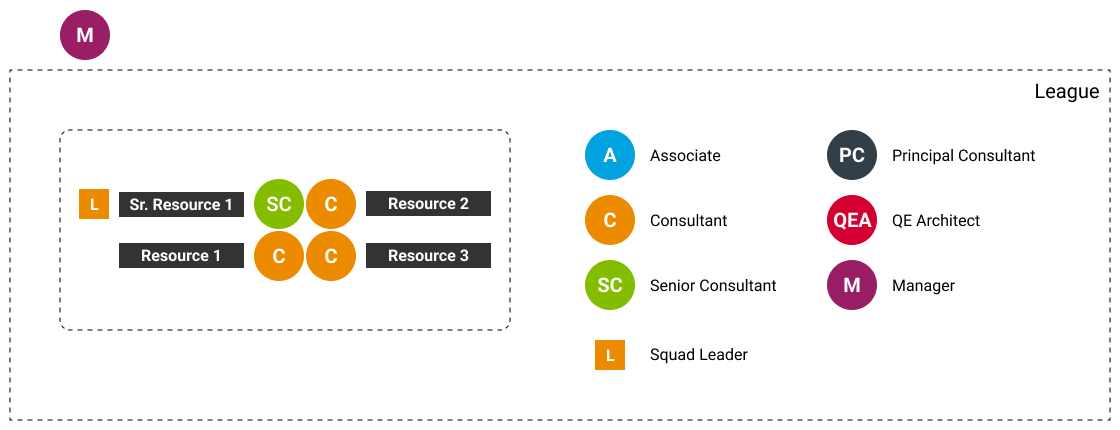Our Ambitious Goal
We knew developing the Best Software Testing Team in the world is an ambitious goal.
To achieve this, we needed to change the way we worked, restructuring our team and giving clients the best combination of skills, experience, and efficiency.
So far, the results have been impressive. We have won the Test Management Team of the Year award two years in a row, beating out Deloitte, IBM, Capgemini, and Tech Mahindra.
Here is a closer look at our journey and how we continue to innovate the software testing space and to provide increasing value to our customers.
Becoming True Software Development Engineers in Test (SDET)
How do you ensure software is functional, scalable, and secure while still allowing for continuous testing, fast time-to-market, and high quality?
We believed that DevOps, agile, quality engineering, and continuous testing are essential pillars for the modern software development process with quality, and the foundational understanding for becoming a true SDET. The challenge is that you must find or train professionals who really understand those pillars, and then implement them correctly.
So how do you build a team of true SDETs?
To start, we formed what we called a true SDET program, which set out a clear, consistent career path for our QA professionals, ensuring that our team members knew what they were working toward in the long term.
In the short term, though, we focused on the development of four key skills:
- Industry knowledge and experience
- Quality Engineering (QE) tactical aspects
- QE strategic aspects
- Soft Skills and Leadership
Training content was created for these four skills, with a new rotation plan that encouraged team members to work on multidisciplinary engagements across different projects, challenges, and technologies.
Restructuring the Team
If identifying key skills and laying out a development path was step one, the next step was ensuring that our team was set up for success.
This required restructuring the team to focus on the following dimensions:
- Quality engineering transformation
- Team organization transformation
- Investment in research and development, focused on quality engineering applied to emerging technologies (i.e., testing non-deterministic systems, highly configurable and connected systems, autonomous vehicles, drones, and robots, etc.)
We then chose experts with more than two decades of experience in consulting, and software quality and testing, that were assigned to lead the implementation of the proposed restructure.
Identifying Risks and Challenges, and Adjusting
The team was enthusiastic about the new plan and understood the mission, but some challenges had to be properly addressed.
First, it was difficult finding individuals with all four key skills well developed, which meant that all team members had to focus on skills development, in one area or the other. The challenge, however, was that many of our employees needed a mentor or someone to teach them more difficult concepts and skills, particularly around emerging technology, which often required included sophisticated abstract concepts.
Secondly, we had to address the manager span of control with consultants feeling isolated without much direct manager interaction as well as with colleagues.
Structuring Along Squads and Leagues
To address these challenges and take the next step, our Test Management Team developed a creative, efficient solution inspired by the Spotify Agile structure.
First, we organized our QA team members into Squads of three people and then fixed these groups across different engagements or projects. The goal was to have all four key skills covered by combining the skillsets of each team member. This was then bolstered with a squad leader, who met stringent criteria, including seniority, leadership experience, and effective communication skills.
Support did not end there, however, as a group of Squads was then formed into a league, which itself was led by a very senior and technically strong professional who had all four key skills and vast management experience and knowledge of several industry domains. Each league is formed by up to 6 Squads.

An example of the Squad Structure in a League
Advantages of Being Organized through Leagues and Squads
From a cultural point of view, small squads made it easier to get our people together, build stronger relationships with other consultants, and ensure that team members get proper guidance from Squad and League leaders.
We now have a flatter organizational structure, with distributed leadership responsibility. Squad members report to Squad leaders who then report into more technical League leaders, all of which is underpinned by a clear career path, making members feel part of something bigger than themselves.
By fixing groups assigned to new projects together – instead of a new team in every engagement – we were also able to streamline communication process, knowledge sharing, and support. Communication with consultants now has multiple channels – from Delivery leadership, their League Leader, and their Squad leader.
Teaching complex emerging technology and onboarding new consultants has also been improved, as Squad members now provide support and tips to learn complex subjects and get new hires up-to-speed.
Most importantly, our new structure offers customers an entire Squad of professionals at their disposal, combining all four key skills to ensure they get a very productive team able to creatively solve any technical challenges and ensures the very best testing in the world.
